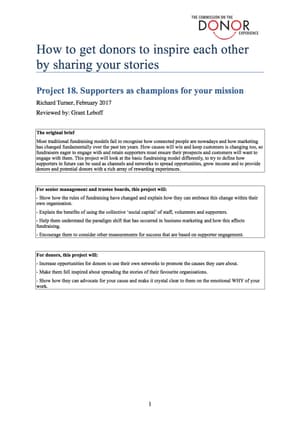CDE project 18 section 2: the approach to compiling case examples
- Written by
- The Commission on the Donor Experience
- Added
- April 29, 2017
Content outline
The next section expands on putting the principles and actions into practice. It starts with references to published works that support this approach to fundraising, i.e. to fully understand the paradigm shift that has taken place and the principles that follow. Further sections expand on each of the actions recommended in the Summary.
Each action overlaps with the next and follows a sequence. For example, if you first understand the paradigm shift that has taken place, you are more likely to adopt a different mindset. As you use that different mindset and tell your mission story, you realise how it is stronger coming you're your supporters.
There is at least one case example provided with each action, apart from the first action on understanding the paradigm shift and the last action on measurement, which points to another CDE project. After each case example there are suggested questions for your organisation to consider.
SolarAid deliberately adopted this approach to its fundraising for a five-year period. It is, therefore, the main case example used throughout, and Richard Turner, former Chief Fundraiser at SolarAid, provided it. During this time, despite a steep learning curve, unrestricted income grew fivefold without a comparable investment in fundraising spend. More importantly, the organisation significantly increased its impact on the lives of families in Africa.
Anthony Nolan has built a reputation for instilling 'Relationship Fundraising' and has achieved consistent growth in its three main areas: income, number of stem cell donors recruited and awareness. The average income fundraised by an individual is three times the national average and the net income from community fundraising has grown four-fold in four years. As part of its approach to enable its supporters to tell their stories, Anthony Nolan recently set up an engagement division headed by Richard Davidson, Director of Engagement, who submitted examples of their approach.
Charity: water has long been admired by UK fundraisers for its focus on peer-to-peer fundraising and has been included for this reason. Angharad McKenzie, Head of Key Relationships, has provided relevant examples.
Stewart Graham, Individual Giving and Legacies Manager, has included a case example on the mindset adopted by Henshaws, after hearing about this project as part of the sector communication by the CDE.
Giles Pegram CBE offered the NSPCC Full Stop Campaign as a powerful reminder of donors leveraging their networks.
Alzheimer's Society was approached for its extraordinary ‘Songaminute Man’ story by a supporter. Michael Dent, Director of Fundraising, provided the background.
In addition, Anne-Marie Huby, co-founder of JustGiving, provided some useful insights on social sharing and the inspiring story of Caroline Jones. The founder of Donative, Laurie Ainley, highlighted the inspiring example of the Australian Tourist Board in getting people to share their stories.
Finally, there is an outline of the characteristics you could expect to see from an organisation that applies this mindset and adopts an approach that leads to winning supporters as champions of its mission.
Fundraising practitioner Richard Turner compiled the project, including the principles and recommended actions. Fundraising consultant Matthew Sherrington provided a peer review. Grant Leboff, author of Sticky Marketing and Digital Marketing, provided further guidance and also reviewed the final document. Appendix 2 is a summary of his speech delivered at a lunch hosted by Flow Caritas and attended by an experienced group of Directors of Fundraising from some of the UK’s leading charities.























